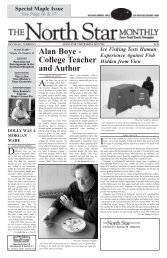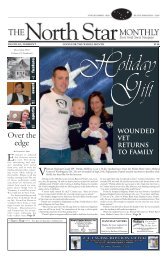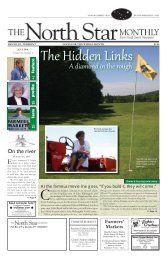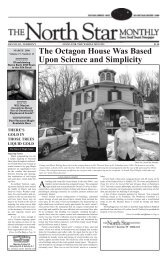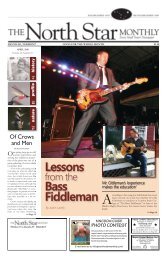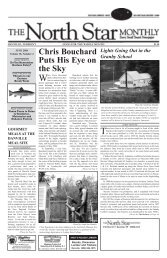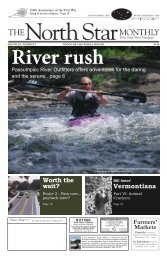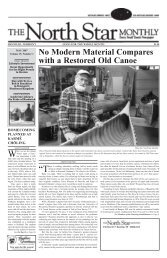Walking the llama trail - The North Star Monthly
Walking the llama trail - The North Star Monthly
Walking the llama trail - The North Star Monthly
- No tags were found...
Create successful ePaper yourself
Turn your PDF publications into a flip-book with our unique Google optimized e-Paper software.
10 NOVEMBER 2009 THE NORTH STAR MONTHLYFollow<strong>the</strong>Money“GUNS OR BUTTER OR...”BY RACHEL SIEGELEducation is a growthsector of <strong>the</strong> economynow. Enrollment is up asemployment is down. <strong>The</strong>competitive advantage of adegree in this labor markethas become an easier sell,and <strong>the</strong> unemployed havetime on <strong>the</strong>ir hands. Besides,<strong>the</strong> o<strong>the</strong>r growth sectorsand job creators of <strong>the</strong>economy—professionalservices such as healthcare—also require skilledand educated workers.Health care is a growth sectorbecause our population isaging, and as it does, it is requiringmore care. <strong>The</strong>re’s morecare to be had, as medicine exploresnew ways to treat chronicconditions that we now live longenough to want to endure morecomfortably. And health care isgrowing because that’s whereour innovative talents go, becausethat’s where <strong>the</strong> money is.As we expand our knowledge ofcare, we devote more resources,especially public resources, to it.<strong>The</strong> money, in turn, attracts researchersand innovators as wellas practitioners.“Guns or butter” is <strong>the</strong> classiceconomic argument ofwhe<strong>the</strong>r to use scarce resourcessuch as labor and capital forpublic goods, both <strong>the</strong>metaphorical and very real“guns,” or private sector productionand consumption, <strong>the</strong>“butter” (not “bread,” a necessityof life, but “butter,” <strong>the</strong> fatof <strong>the</strong> land). <strong>The</strong> dilemma liesin <strong>the</strong> scarcity of resources and<strong>the</strong> opportunity costs created by<strong>the</strong>ir use: if more went into <strong>the</strong>public sector, <strong>the</strong>re would beless for <strong>the</strong> private sector, withits innovators and engines ofeconomic growth.<strong>The</strong> decision of whe<strong>the</strong>r ornot to take on health care as apublic good can likewise beframed as one of taking resourcesout of <strong>the</strong> creativeeconomy and devoting <strong>the</strong>m topublic goods. In addition to <strong>the</strong>public bearing <strong>the</strong> costs of <strong>the</strong>health care itself, <strong>the</strong>re is also<strong>the</strong> cost of <strong>the</strong> sacrifice in innovationand growth from <strong>the</strong> privatesector, deprived of thoseresources.<strong>The</strong> argument is not thatsimple, however. <strong>The</strong> assumptionthat defense, for example,does not create and thus limitsgrowth is proven false by <strong>the</strong>many products and services thathave come to consumers asadaptations of military researchin such varied fields as communications,transportation, nuclearphysics, and … medicine,with advances in acute woundcare, anes<strong>the</strong>sia, antibiotics, andstress disorders, etc. Defensealso creates jobs that do not requirehigher education, while inturn providing military benefitsthat allow pursuit of educationand re-entry into <strong>the</strong> civilianworkforce as more productiveworkers.In <strong>the</strong> debate about how orhow much health care to provideas a public good, naturalparallels are drawn to o<strong>the</strong>r developednations that have providedsuch services for yearsand manage to maintaineconomies that are thrivingenough to provide an acceptablequality of life.In fact, in those countries it’snot a question of taking resourcesaway from <strong>the</strong> privatesector and <strong>the</strong>refore from economicgrowth in order to suppor<strong>the</strong>alth care, it’s a matter ofwhich public goods are produced.In developed economies,<strong>the</strong>re is usually an inverse relationshipbetween military andsocial spending. So far, we havechosen guns; o<strong>the</strong>rs have optedfor gauze.As a subject of <strong>the</strong> 18th centuryBritish Empire, protectedby <strong>the</strong> Royal Navy, Adam Smithsuggested that a primary role ofgovernment was to protect aneconomy so that it would besafe enough to enjoy <strong>the</strong> gainsfrom trade. We have followedsuit in developing our military in<strong>the</strong> post-War era, and that hasnot deprived us of empire. Despite<strong>the</strong> costs of defense, wehave managed economic growthand enviable living standards.We have plenty of butter.It is tempting to look backon World War II as <strong>the</strong> awfulbut effective catalyst that restoredemployment to our depressedeconomy, not only in<strong>the</strong> military but also in <strong>the</strong> factories.In turn, that led to an ageof manufacturing as <strong>the</strong> driverof innovation and employment—aprosperous era ofproduct and job creation—andof military spending. Now, insteadof younger men who need<strong>the</strong> jobs that <strong>the</strong> military cancreate, we have an aging populationthat needs <strong>the</strong> care thatresearch and science can create.Ra<strong>the</strong>r than public healthcare becoming a drain on resourcesand economic growth, itmay actually shift our use of resourcesto be more in line withour changed needs, and <strong>the</strong>reforebe a more productive andefficient catalyst for growth.Perhaps this will lead to ano<strong>the</strong>rprosperous era, this timebrought by knowledge insteadof guns—or butter.Rachel S. Siegel, CFA, consultson investment portfolio performanceand strategy, and on accountingdilemmas. She is a professor in <strong>the</strong>business administration departmentat Lyndon State College. “Follow <strong>the</strong>Money” has been a regular feature in<strong>the</strong> <strong>North</strong>star since 2001.Sanderson’s Wooden BowlsPerfect for that Special GiftEach Bowl is Hand-turnedfrom Native VermontHardwoodwww.vtbowls.comSam & Weeza Sanderson2902 VT RT 114 East Burke, VT, (802) 626-9622Visitors Always Welcome



